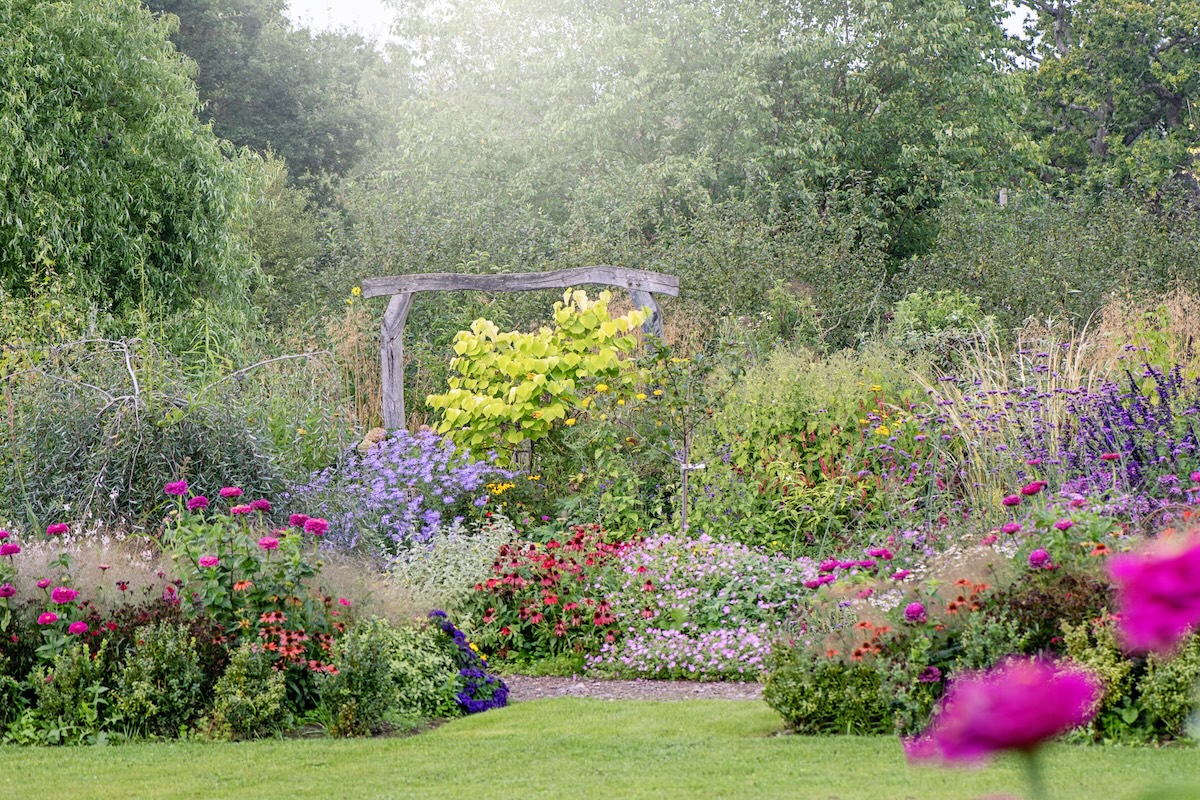

We may earn revenue from the products available on this page and participate in affiliate programs. Learn More ›
The glory of midsummer flowers is celebrated in poetry and song, but there are plenty of late-summer flowers that can give your garden a much-needed pop of color amidst that sea of green. From long-lasting flowers that just won’t quit to vines that are just getting started when fall arrives, here are some of the best summer flowers to plant for late summer and fall color.
1. Coneflower (Echinacea)
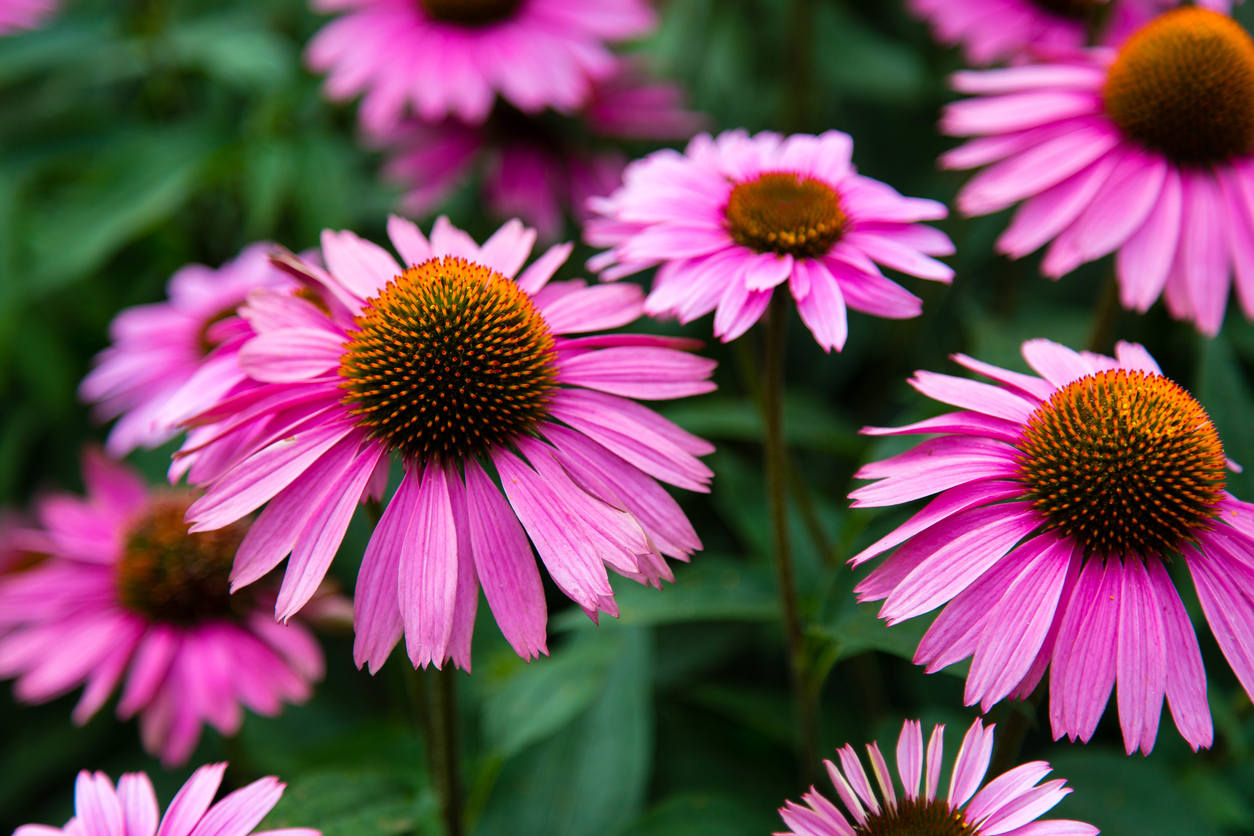
USDA hardiness zones: 3 to 8
Size: Up to 4 feet high, 2 feet wide
Native to eastern and central North America, this hardy perennial can handle cold snaps down to USDA Plant Hardiness Zone 3 but is a successful bloomer in milder climates as well. It blooms from early summer to fall (in milder climates it might even bloom from spring to fall) with long-lasting flowers that attract pollinators.
The most popular is the purple coneflower (E. purpurea), which includes the classic purplish-pink flowers strongly associated with the genus. However, coneflowers come in plenty of other colors, including white and the hybrid E. purpurea ‘Green Envy.’ Plant coneflowers in full sun with other sun-loving plants and water them moderately; echinacea can be quite drought-tolerant once established.
2. Zinnia (Zinnia elegans)
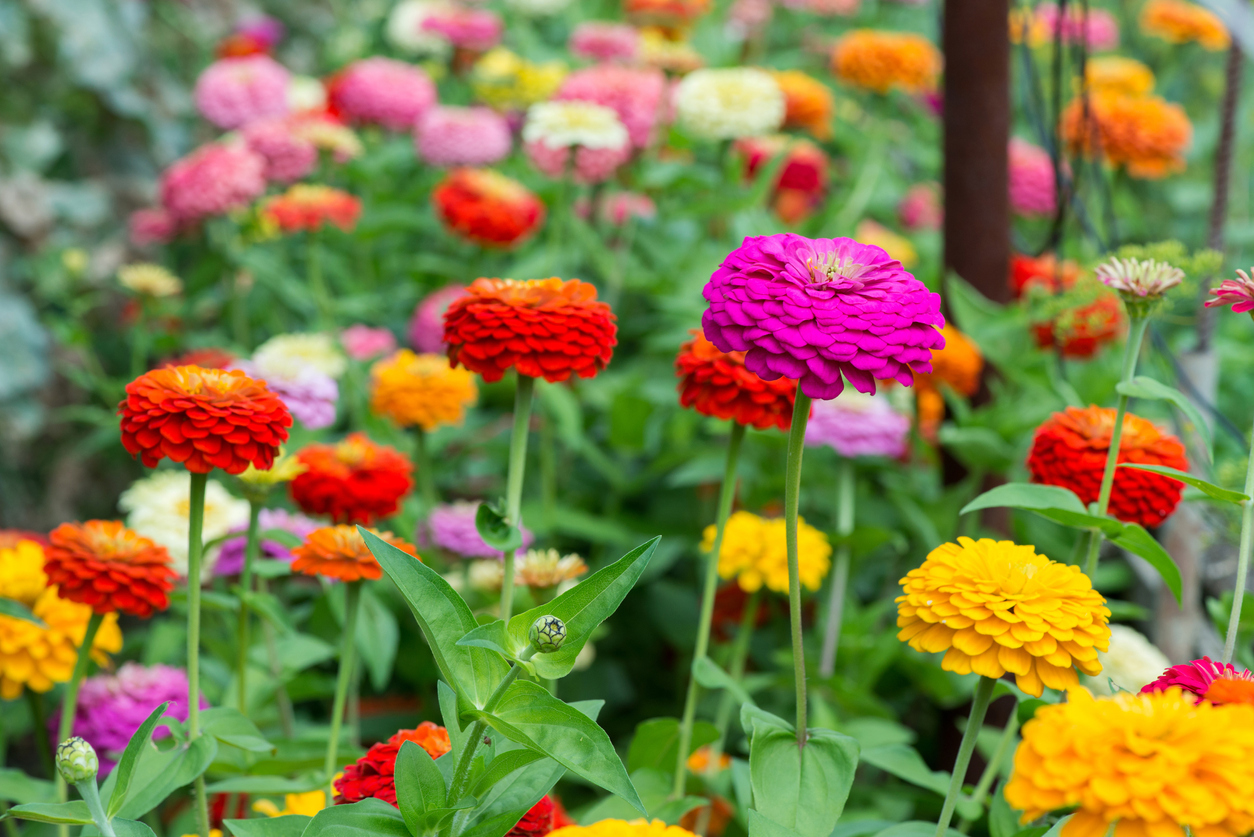
USDA hardiness zones: 2 to 11
Size: Up to 4 feet high, 1 foot wide
When it comes to flowers that bloom all summer, zinnias take the cake. Their vibrant colors run from hot pink to deep orange, and they last long. Plant these annual summer flowers in the beginning of the season and with proper deadheading, you’ll have flowers well into the fall. Zinnias also take a variety of flower forms, including single, semi-double, double, dahlia, globe, cactus, and even scabiosa for its resemblance to the pincushion flower.
Zinnias are full-sun flowers, and also prefer rich soil and regular water, but be mindful not to water from overhead, which can damage the flowers and encourage powdery mildew. Fertilize throughout the growing season with an all-purpose, water-soluble fertilizer such as 10-10-10.
3. Autumn Joy Stonecrop (Hylotelephium spectabile ‘Autumn Joy’)
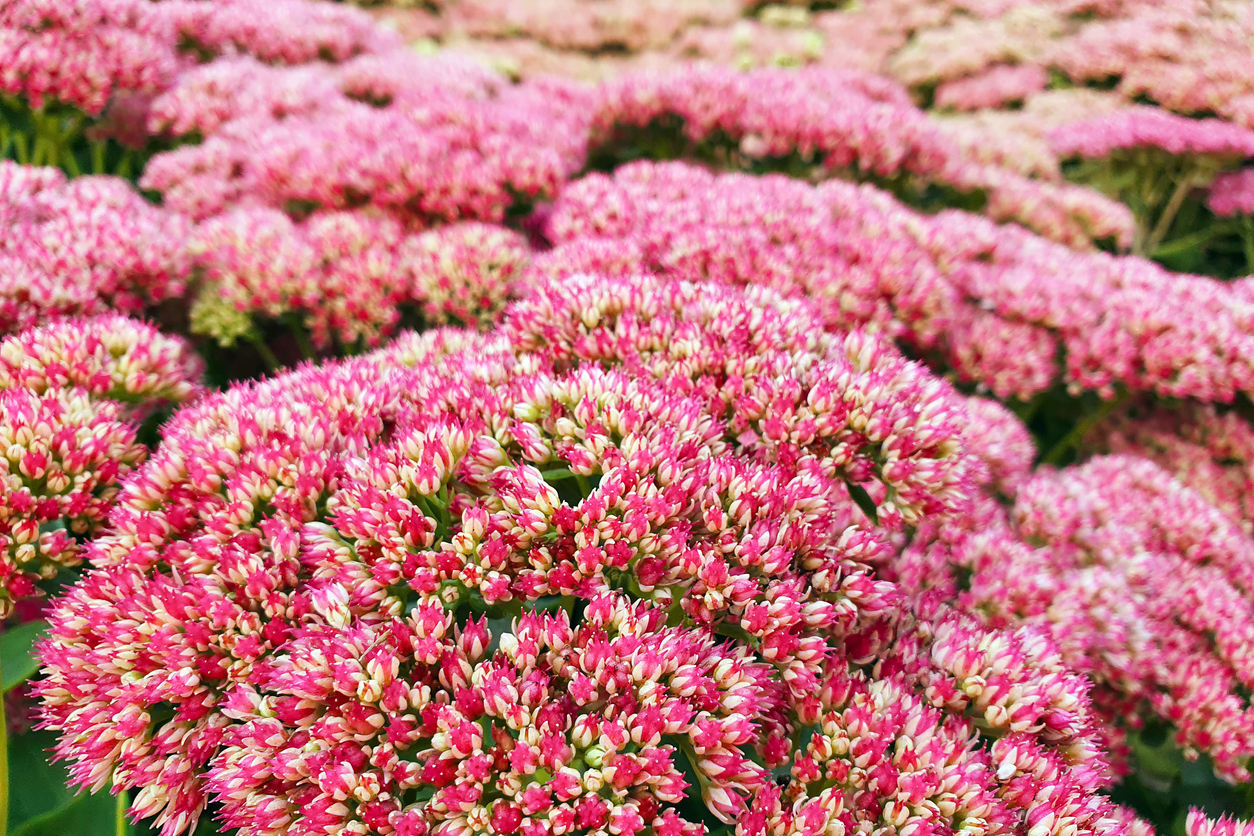
USDA hardiness zones: 3 to 10
Size: 2 feet high and wide
Though stonecrop, most often known as sedum, might look like a tender succulent, these hardy perennials come back looking bigger and better every year. With lush leaves and flowers forming in midsummer, the burst of pink flowers in August that gradually turn to a deep rust color into the fall keeps your garden looking colorful long after other flowers have faded.
Autumn Joy stonecrop prefers full to partial sun and thrives in rock gardens or crevice gardens. Its flowers attract butterflies and bees. Autumn Charm sedum (Sedum telephium ‘Autumn Charm’) has similar flowers but variegated leaves.
4. Cosmos (Cosmos bipinnatus)
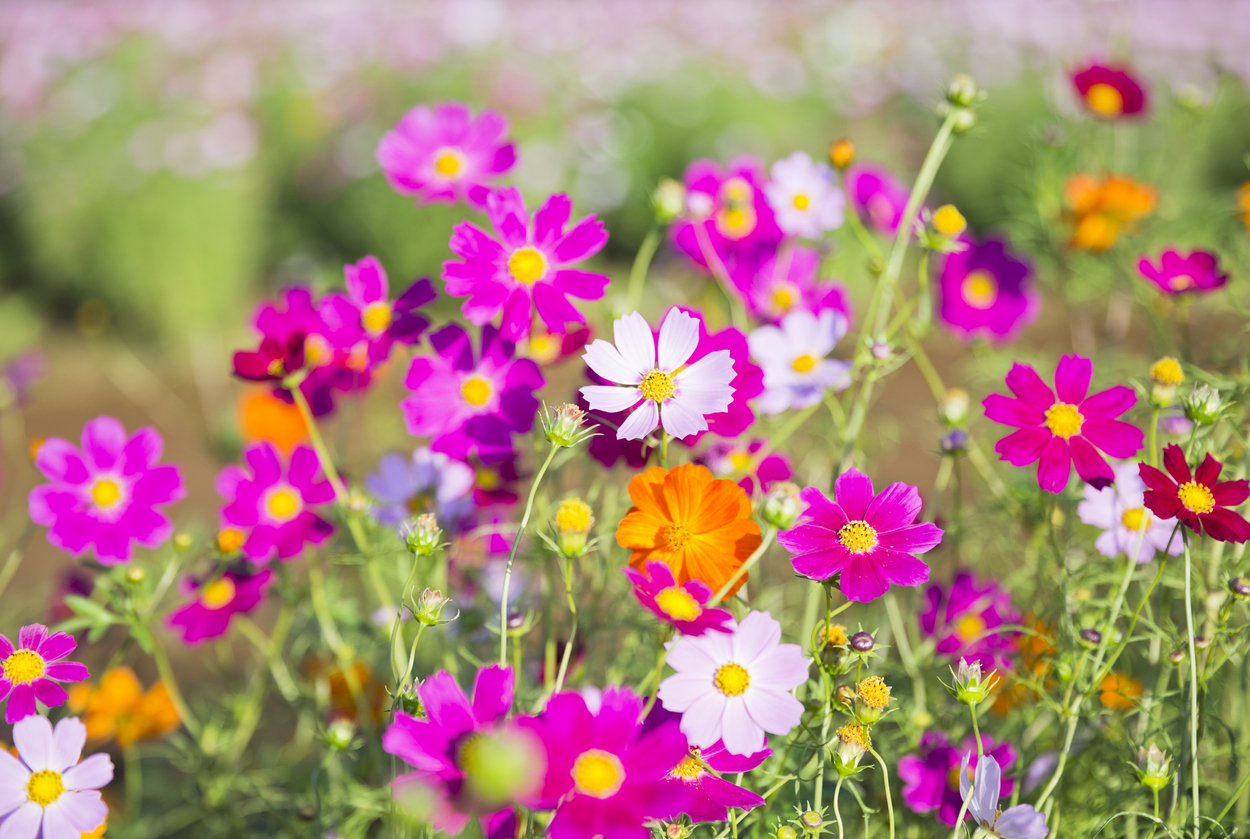
USDA hardiness zones: 2 to 11 (annual)
Size: 1 to 6 feet high, 1 to 3 feet wide
Frequently grown for cut flower arrangements, this delicate-looking annual is surprisingly tough. Sow the seeds directly in the ground in early spring, or start them indoors and transplant them after frost in colder climates. The best part is that cosmos flowers frequently self-seed for the following year. And while the most popular color is the signature pink, cosmos actually come in shades of white, pink, purple, and even deep red.
Another lovely late bloomer is the chocolate cosmos (Cosmos atrosanguineus), which sports deep red flowers that have a smell like cocoa powder. Plant tubers in full sun and deadhead the flowers regularly to encourage new blooms.
5. Sunflower (Helianthus annuus)
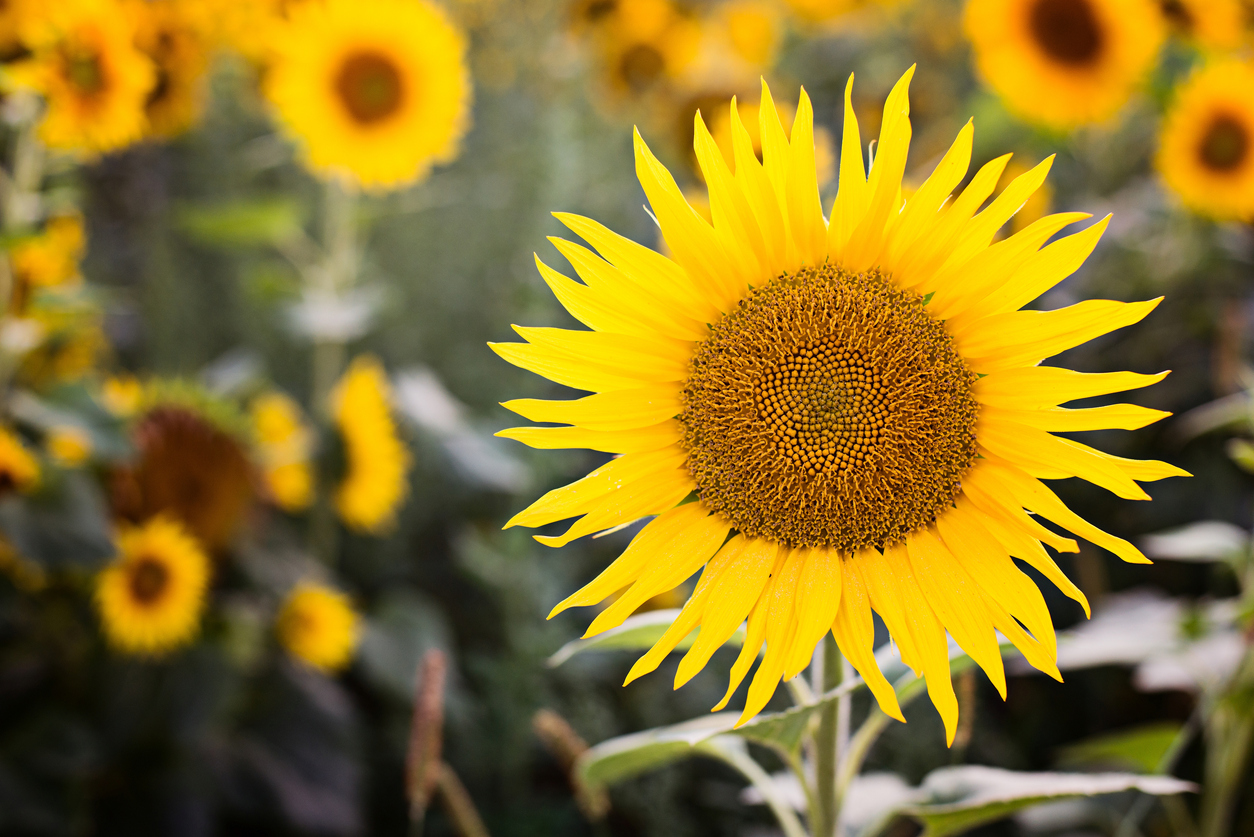
USDA hardiness zones: 6 to 9, annual
Size: 1.5 to 10 feet high, depending on variety
A favorite annual summer flower, sunflowers are the consummate late bloomer, starting to open in late summer and flowering into the fall. Sunflowers are known for their cheerful yellows (think Van Gogh’s famous paintings), but they also can feature bright orange, deep red, and even pale pink flowers.
Heirloom varieties like Astra Rose Cream bloom in a soft pink color with yellow and black centers and the 10-foot-tall Arikara sunflower is a native prized by the MHA Nation tribe of the same name in North Dakota. These late bloomers need full sun and usually a vertical space to grow. Most sunflowers require some kind of staking or tying to a fence or pole to keep them upright during summer storms.
6. Flowering Sage (Salvia spp.)
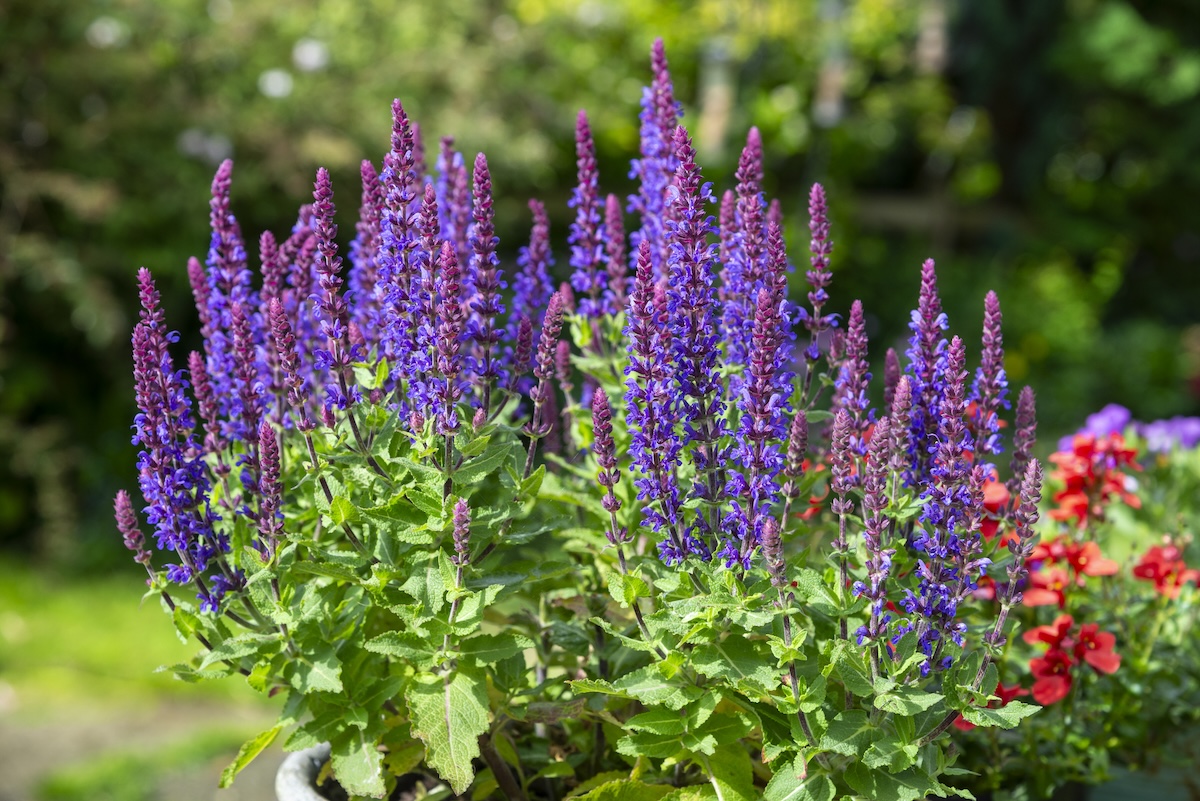
USDA hardiness zones: 5 to 10, or annua
Size: Up to 5 feet high, 1 to 4 feet wide
Salvias are garden flowers related to culinary sage that love full sun and bloom continuously into the fall. Many are perennials, even in colder climates. Particularly showy and cold-tolerant down to Zone 6 is Salvia greggii, including the show-stopping Raspberry Delight and Ultra Violet hybrids. For showy blue flowers from late summer to the fall, look for Prairie Sage (S. azurea), a perennial down to Zone 5.
The silvery leaves and unusual flowers of Andean Sage (S. discolor) will add an element of surprise to the summer garden: the small flowers are deep purple—nearly black—and have a berry-like smell. This is a tender perennial in Zones 9 and above; everywhere else, grow it as an annual.
7. Bee Balm (Monarda spp.)

USDA hardiness zones: 4 to 9
Size: 2 to 4 feet high by 2 to 3 feet wide
The North American native perennial Monarda gets going in midsummer with spikes of pink, red, magenta, or white garden flowers through the fall. As the common name “bee balm” might suggest, it’s a favorite of bees—but also of hummingbirds. It’s also often referred to as horsemint and wild bergamot. Monarda prefers the full sun but can take light shade. The plant is aromatic and has been used in tea for centuries.
Bee balms need regular water, though all but dwarf Monarda pringlei will develop powdery mildew on the leaves, so water at the base of the plant and not overhead. Deadhead faded blooms right away to encourage new blooms.
8. Dahlia (Dahlia spp.)
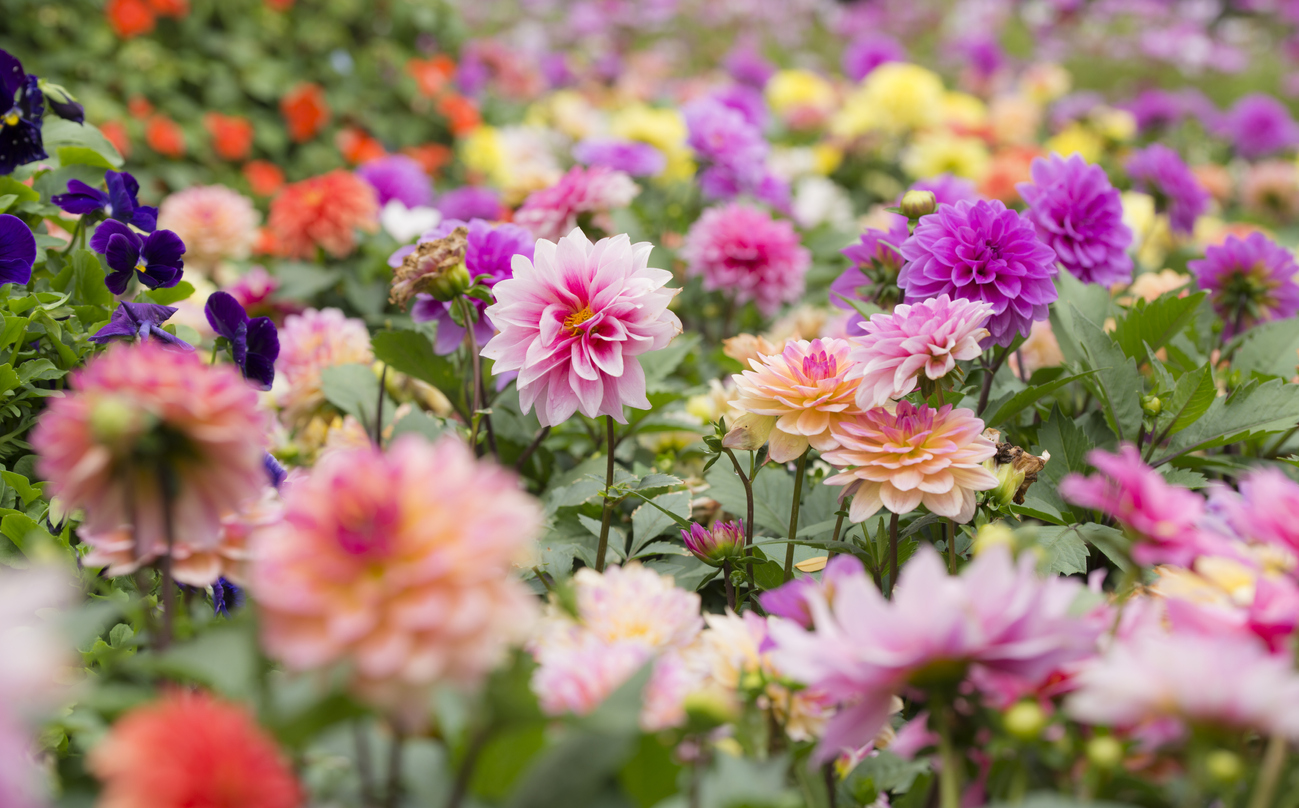
USDA hardiness zones: 8 to 10
Size: 1 to 6 feet high, up to 3 feet wide
Dahlias really hit their stride in late summer with blooms extending well into October in milder climates. If you can think of a shape or a color, there is probably a dahlia to match it. Dahlia flower forms include ball, pompon, orchid, collarette, and more. You’ll also find them in every color, from creamy peaches to red-and-white stripes, and flower sizes that range from a petite 2 inches to a massive 10 inches or wider. Dinnerplate dahlias are known to reach 15 inches across.
In all regions colder than Zone 8, gardeners must dig up dahlias from the garden each year before the ground freezes and replant them in the spring. They are prone to powdery mildew, so be sure to water them at the base of the plant and not overhead. Dahlias can take sun to light shade, especially in hot climates.
Muhly Grass (Muhlenbergia capillaris)
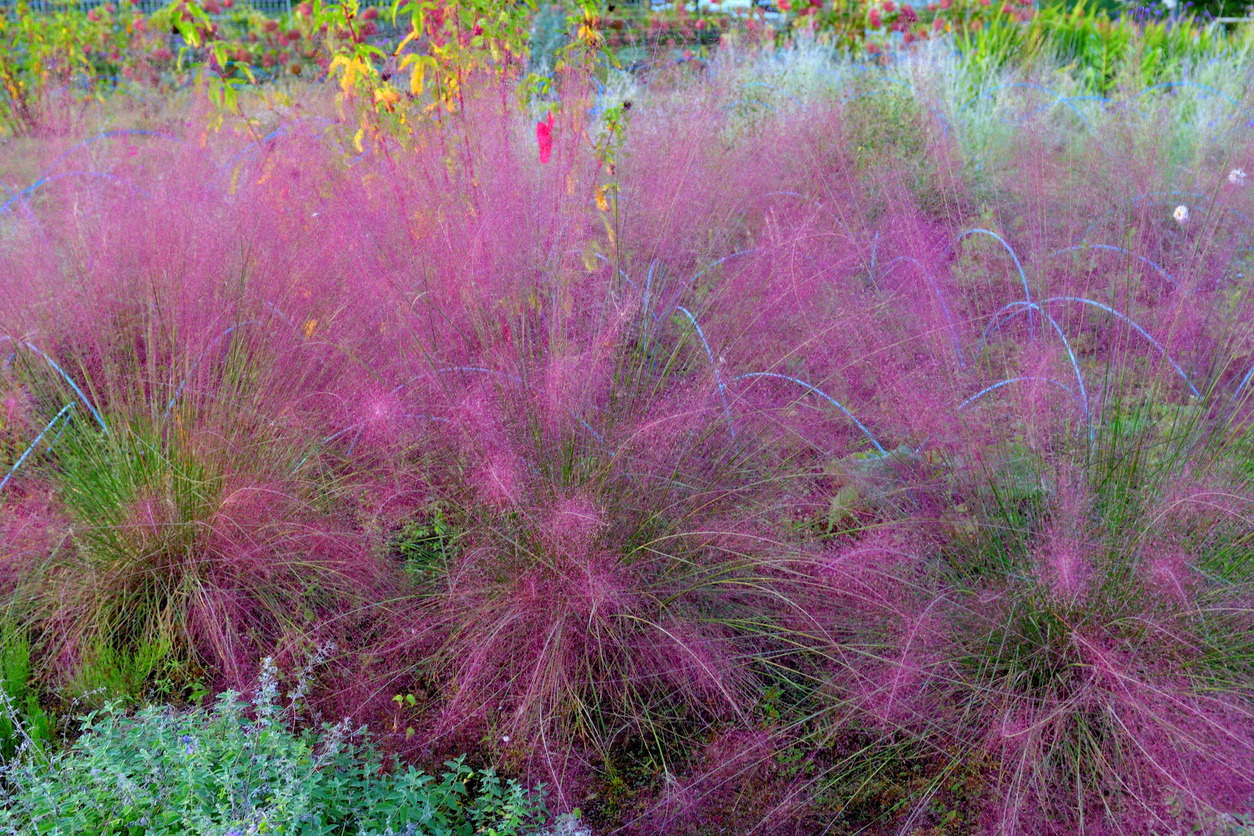
USDA hardiness zones: 5 to 9
Size: 2 to 3 feet high and wide
A perennial grass adds texture and variety to the garden, but it can also add a big burst of late summer color. Many varieties of muhly grass are native throughout North America—from Southern California to the prairies of the Midwest all the way to the Northeast. Their cold tolerance for overwintering depends upon the exact variety, but most muhly grasses produce beautiful flower spikes in rosy pink colors that get only more brilliant as fall creeps in and they go to seed.
Look for Regal Mist for a big burst of pink, or the surprising White Cloud for fluffy white flowers that stand out in the garden. Most muhly grasses grow about 2 to 3 feet high and wide, though some can get significantly larger. Plant them near sun-loving shrubs in well-draining soil.
10. Black-Eyed Susan (Rudbeckia spp.)
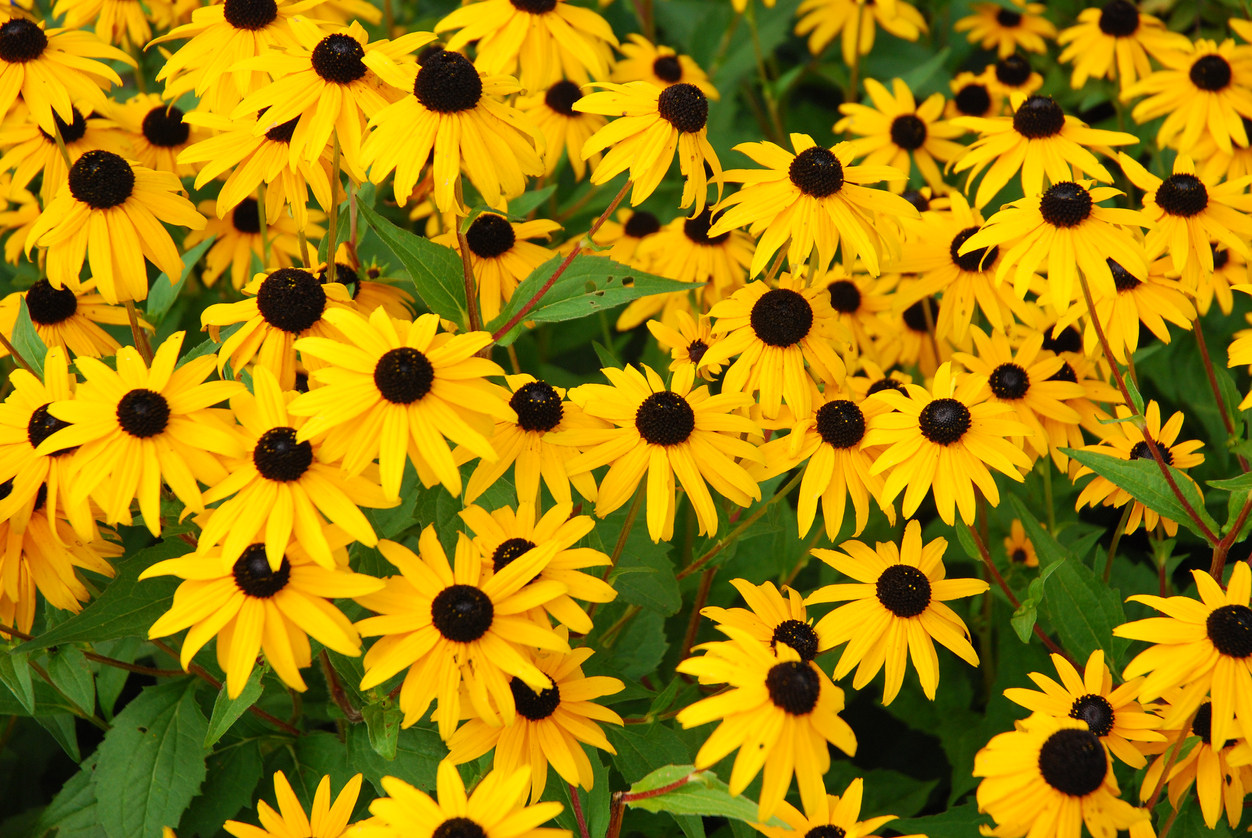
USDA hardiness zones: 3 to 9, or as annual
Size: Up to 3 feet high and 2 feet wide
Black-eyed Susan is a reliable staple of the summer garden, known to bloom on repeat until late fall. Their signature dark-black center with yellow petals make for beautiful outdoor flowers and indoor stunners in autumnal floral arrangements, especially when paired with sunflowers and grasses. The native to the Central U.S. is hardy in Zones 3 to 7 as a perennial. Most prefer full sun but can tolerate light shade in hot climates.
The most common species is Rudbeckia fulgida. Cultivars like Goldstrum can grow more than 2 feet tall; dwarf Little Goldstar reaches just under 16 inches and looks great in pots with other sun-loving container plants like petunias. R. grandiflora can grow to more than 40 inches high, a great size for mass plantings to attract lots of pollinators. R. hirta often has showier flower hybrids, with colors like deep orange with yellow tips but less cold tolerance than other species.
11. Ornamental Millet (Pennisetum glaucum)
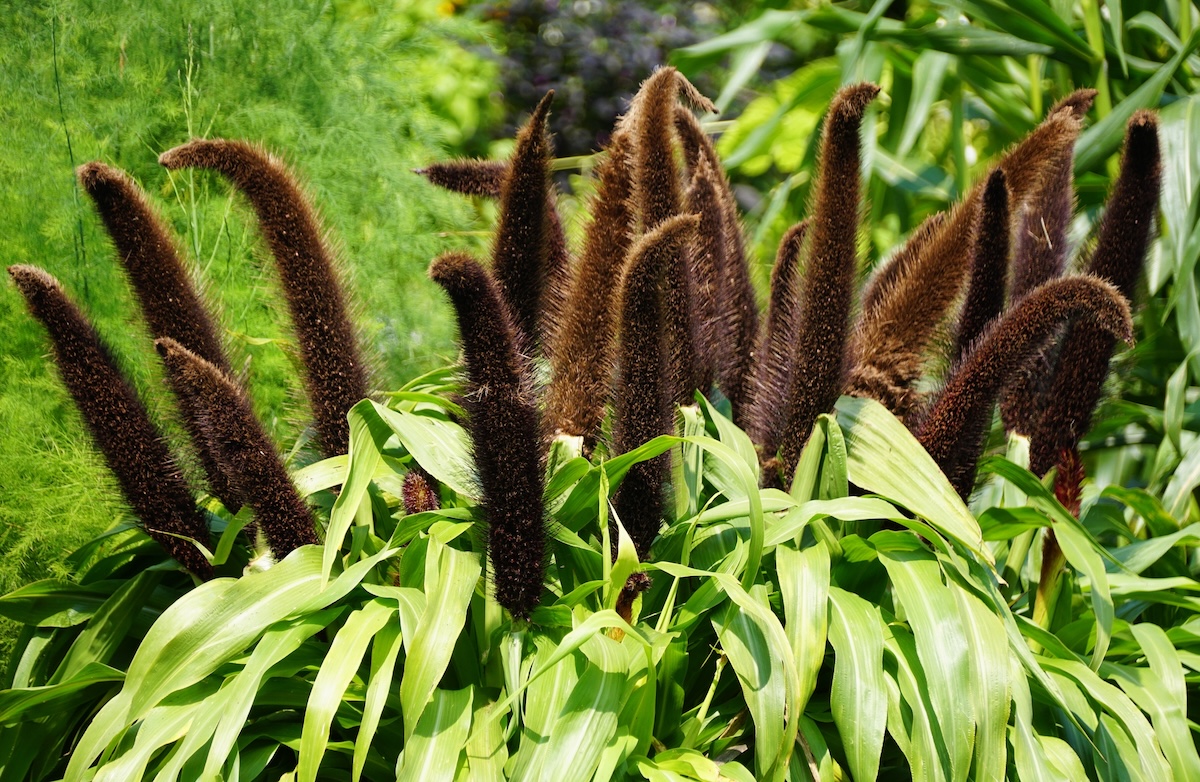
USDA hardiness zones: 10 to 11, or as annual
Size: 2 to 5 feet tall
Popular summer plants like ornamental millet make excellent additions to both summer garden beds and containers. These annual plants achieve good height with low maintenance. Growing quickly to 4 to 5 feet tall, they also make great centerpieces in a pot. Varieties such as Purple Majesty have deep burgundy leaves that look beautiful throughout the early summer, followed by cattail-like flower spikes of the same rich color.
Millet needs full sun to survive but can grow from seed easily. Plant it directly in the ground once frost has passed, and it will take only 60 days or so to flower. Complement millet with lower-growing flowers like petunias or creeping zinnia.
12. Russian Sage (Perovskia atriplicifolia)
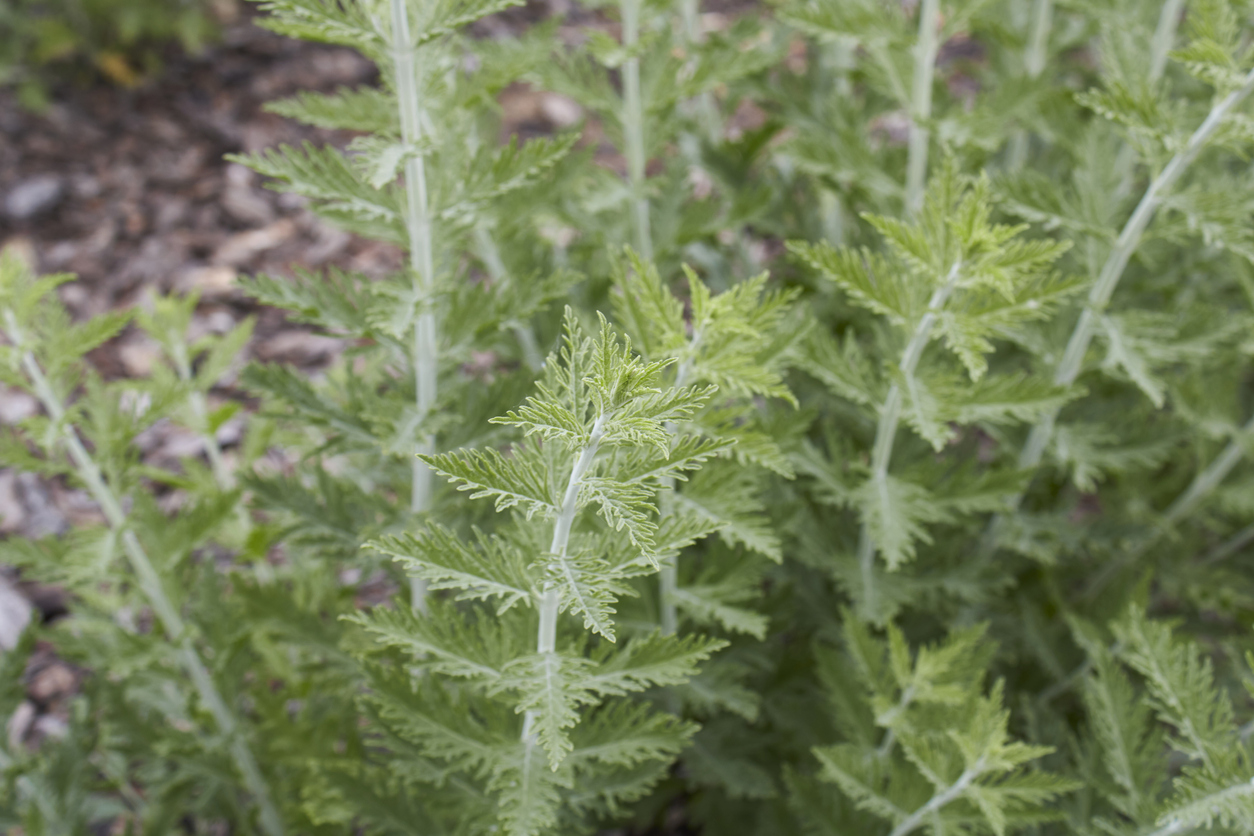
USDA hardiness zones: 5 to 9
Size: 2 to 4 feet high and wide
This beautiful perennial is not a true sage (nor is it from Russia); it’s actually native to Afghanistan, Iran, Pakistan, and Tibet. A pleasing plant in the garden for its silvery, airy foliage that adds texture and color among green-leaved plants, it explodes in a soft purple spray of flowers from summer to fall. Blue Spire is one of the most popular Russian sages for its deep-purple color, and Blue Mist provides a softer blue but a slightly earlier bloom.
Russian sage can grow from 2 to 4 feet wide and as high. Prune lightly after the first bloom to extend the flowering period, and cut the branches down to where new growth appears in spring if you want to control growth. Keep Perovskia in full sun with regular water the first year, but skip the fertilizer. They perform well without it, and are drought-tolerant once established.
13. Hyssop (Hyssopus officinalis)
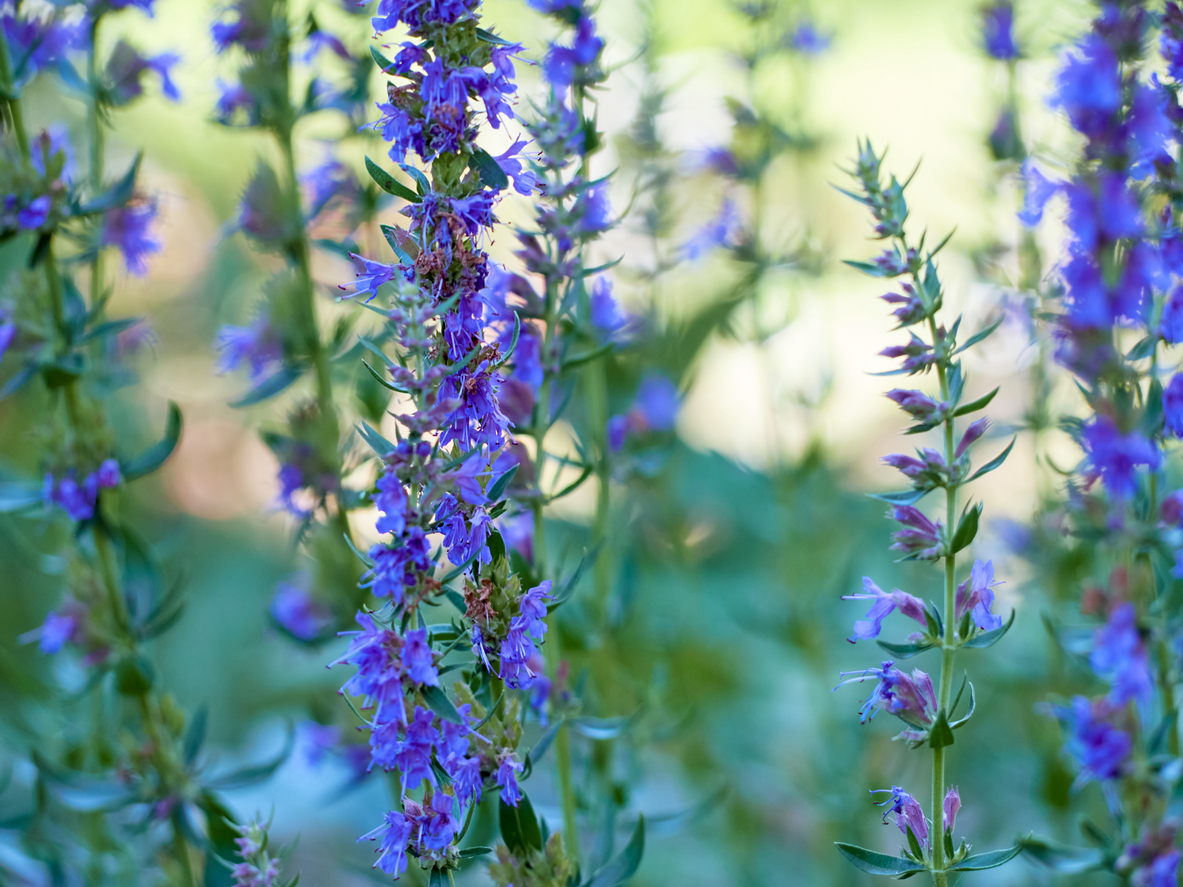
USDA hardiness zones: 4 to 9
Size: 1 to 2 feet high and wide
A fragrant herbaceous perennial in the mint family, hyssop grows to about 2 feet before sprouting prolific dark-blue flower spikes. Its dark-green leaves have a pleasant smell, especially in a warm summer garden and cut flower arrangements. The plant can perform well even in poor soil, but does best in soil that drains well.
Cut hyssop flowers back right after they bloom to get a second round of blooms. Hyssop prefers at least 6 hours of full sun per day. Look for related cultivars that can bloom in white, pink, or coral.
14. Yarrow (Achillea millefolium)
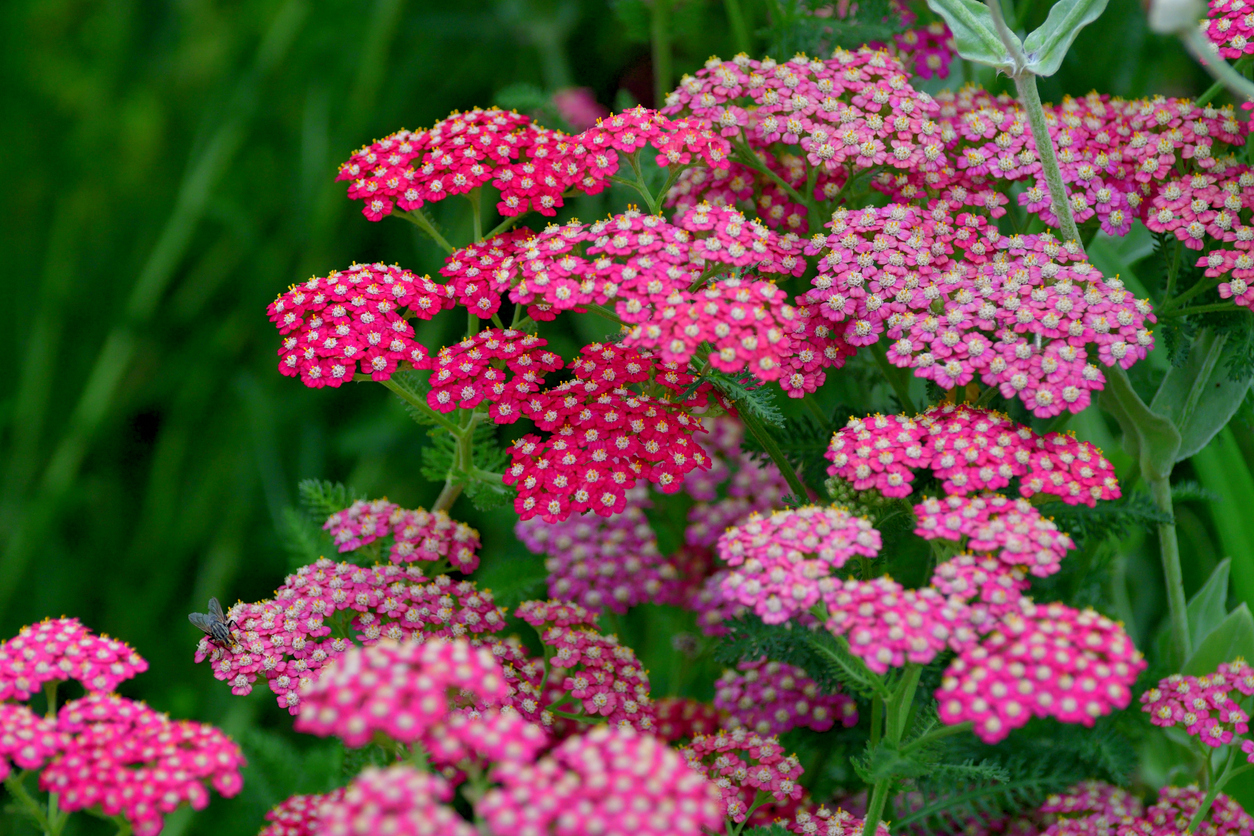
USDA hardiness zones: 3 to 9
Size: 1 to 3 feet high and wide
Also called Common Yarrow, don’t let this plant’s name fool you. The perennial will grow happily in nearly any garden providing it gets enough sun and has well-draining soil. The versatile butterfly favorite looks as good in a mass planting as it does in a cottage garden.
White, yellow, or even red flower clusters form atop narrow, grayish-green leaves, with unique cultivars including the orange and red flowers of Paprika and soft-pink blooms of Pink Grapefruit. The flowers form in late spring, but cutting them back repeatedly can encourage new blooms all the way into the fall. Yarrow is a hardy perennial in Zones 3 to 9.
15. Amaranth (Amaranthus caudatus)
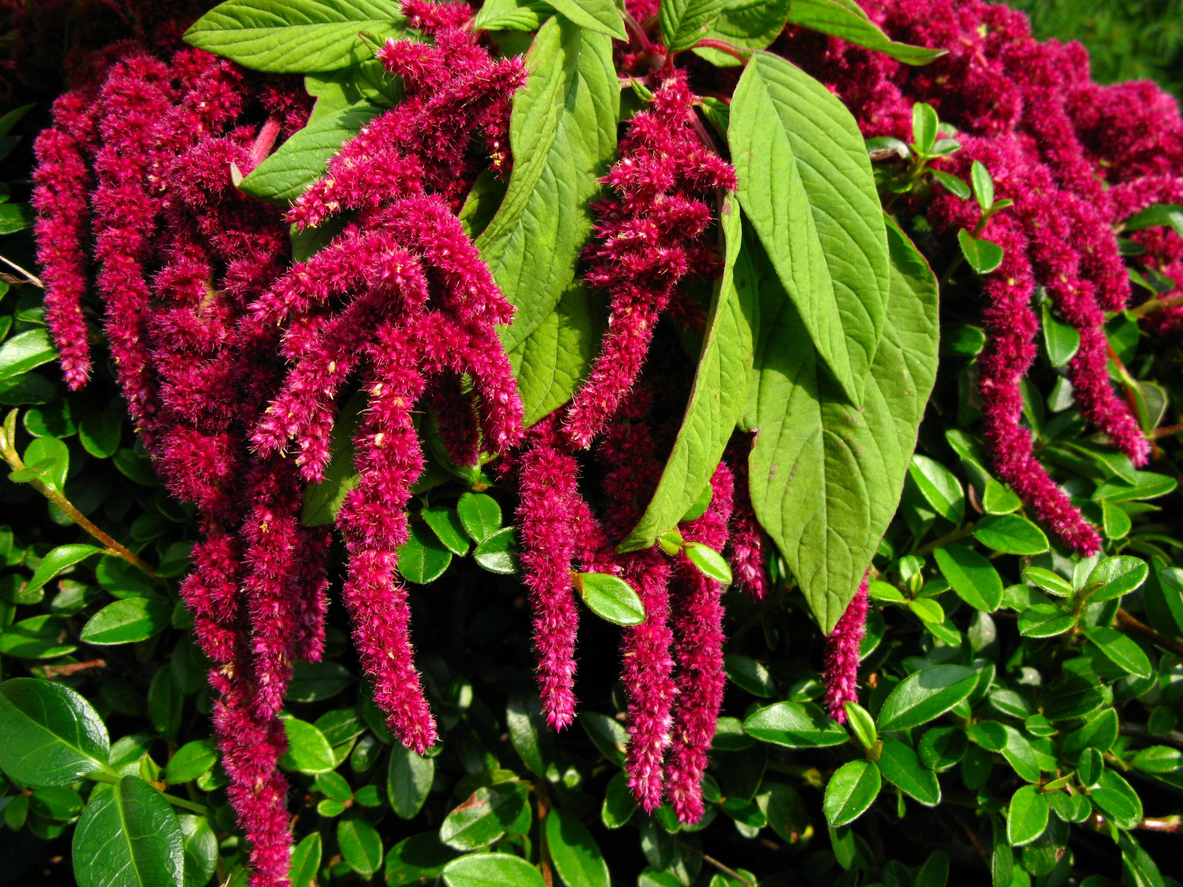
USDA hardiness zones: 2 to 11 as an annual
Size: 3 to 5 feet high, up to 2 feet wide
For a unique display in a garden of upright flowers, the drooping blooms of the annual amaranth (aka love-lies-bleeding) can’t be beat. The sturdy plant boasts branches with wide, light-green leaves and dramatic, drooping, tassel-like flowers in a dark red. Some varieties will grow golden, pale pink, or even emerald green flowers.
Amaranth adds visual interest to late summer gardens, but it may be best grown along a fence where stalks can droop over and show off their trailing flowers. They are extremely drought-tolerant and can handle poor soil once established, no fertilizer required.
16. Lavender (Lavandula spp.)

USDA hardiness zones: 5 to 9
Size: 1 to 3 feet high and up to 2 feet wide
Prized for both their fragrance and uses as an herb, the many species of lavender can make a show in the sunny garden of late summer. The beauty of lavender is that the more you harvest the fragrant flowers, the more flowers it might produce, so start harvesting the outdoor flowers shortly after the plant begins to bloom in midsummer to keep the show going well into the fall. Because lavender tends to grow as a rounded clump, it makes a great border plant.
English lavender (L. angustifolia) is one of the most widely planted, with French lavender (L. dentata) a close second. Look for Goodwin Creek Gray for pretty silvery foliage that is striking against the deep violet flowers from spring to late fall. Hardiness zones vary, but few lavender varieties are hardy below Zone 5. In colder areas, plant it as an annual herb and harvest it before frost or grow lavender indoors. Plant lavender in full sun.
17. Catmint (Nepeta x faassenii)
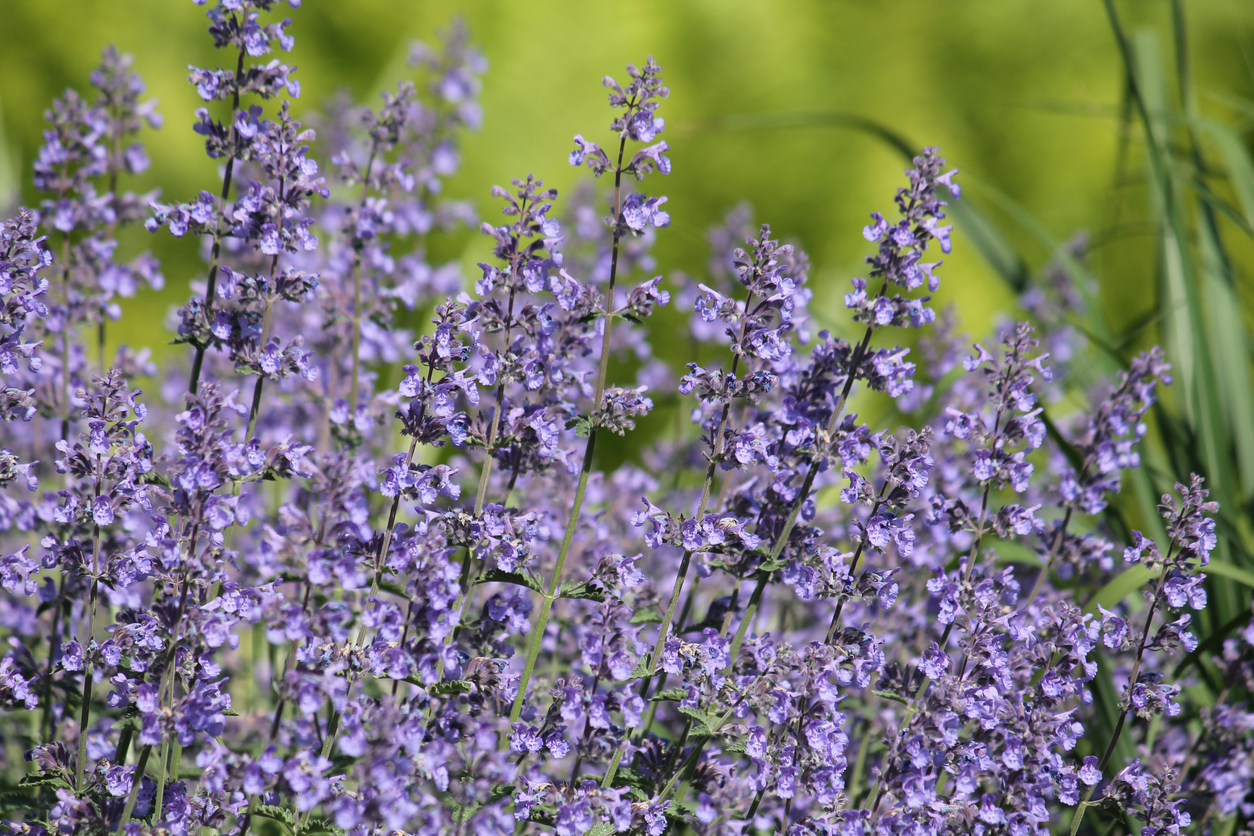
USDA hardiness zones: 5 to 9
Size: 1.5 to 2 feet high, up to 3 feet wide
Not to be mistaken for mosquito-repellent catnip (Nepeta cataria), catmint is grown primarily as an ornamental plant, though it also might be attractive to some cats. Most catmint bloom a profusion of tiny purple flowers in late spring to midsummer; if sheared back after bloom, they will produce a second round of prolific flowers for late summer and early fall.
Hardy as a perennial in some areas, catmint tends to clump (and spread) and can grow 1 to 3 feet wide, with some cultivars growing twice that size. Look for Cat’s Meow and Cat’s Pajamas for striking indigo flowers. Catmints need at least 6 hours of full sun to bloom best.
18. Sweet Autumn Clematis (Clematis terniflora)
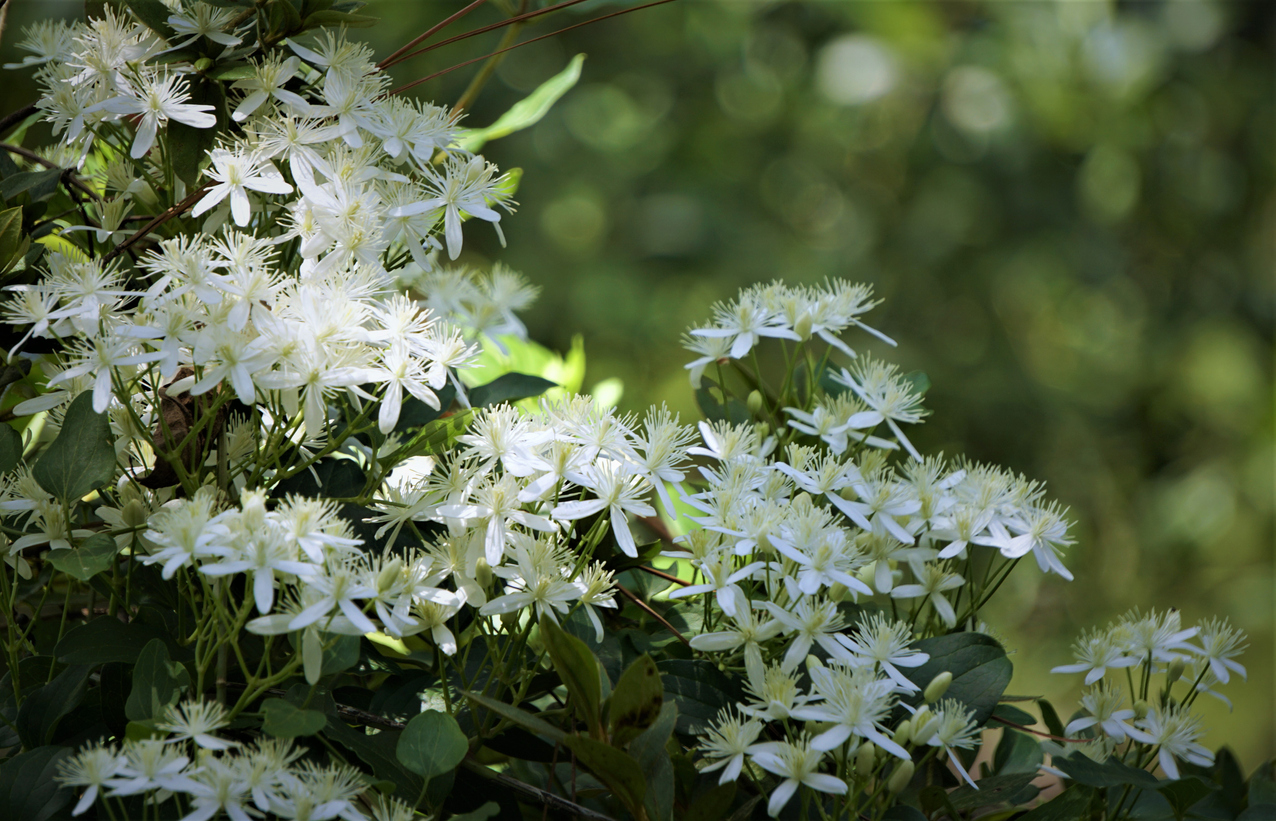
USDA hardiness zones: 5 to 9
Size: up to 30 feet long
A deciduous, perennial vine plant, this climbing Clematis gets going with blooms when the rest of the neighborhood’s flowers have come and gone. A rapid grower to up to 30 feet, the green-leafed vine is covered in hundreds of small, fragrant, white flowers by August or September. Except in very mild coastal climates where full sun is needed, this clematis can tolerate shade. Give it well-draining soil and plenty of low-nitrogen fertilizer in spring to encourage the flower show in the early fall.
19. Flowering Tobacco (Nicotiana spp.)

USDA hardiness zones: 10 to 11, or as annual
Size: 2 to 5 feet high, up to 2 feet wide
Flowering tobacco plants grow in summer as annual flowers but can reseed and even overwinter in very mild climates. Nicotiana alata anywhere features large, fragrant white flowers that open in the evening. N. sylvestris, which can grow up to 5 feet tall, gets long tubular white flowers that are also intensely fragrant. Both varieties look beautiful in a monochromatic moon garden.
Other hybrids of flowering tobacco can produce pale pink to bright pink flowers, and sometimes even lime green or dark purple. Most open at night, but all have a long flowering season spanning from midsummer to fall. Remove the flowers when they fade but wear gloves: the plant and flowers are sometimes sticky. Avoid placing it near tomato plants to decrease risk of infecting tomatoes with tobacco mosaic virus. Flowering tobacco grows in full sun to partial shade.
20. Common Hop (Humulus lupulus)

USDA hardiness zones: 4 to 9
Size: 15 to 20 feet long
The common hop vine is a deciduous perennial vine that can grow as long as 15 to 20 feet. The female flowers, which appear in late summer, look like light green cones that have a distinctive fresh fragrance, most recognizable as the flavoring in many beers.
Only the female flowers produce the butterfly-attracting hops (the male plants produce flower panicles), but most varieties sold in nurseries are typically female. Hops thrive in full sun and must be cut all the way to the ground to produce flowers each year.
21. Hollyhock (Alcea rosea)
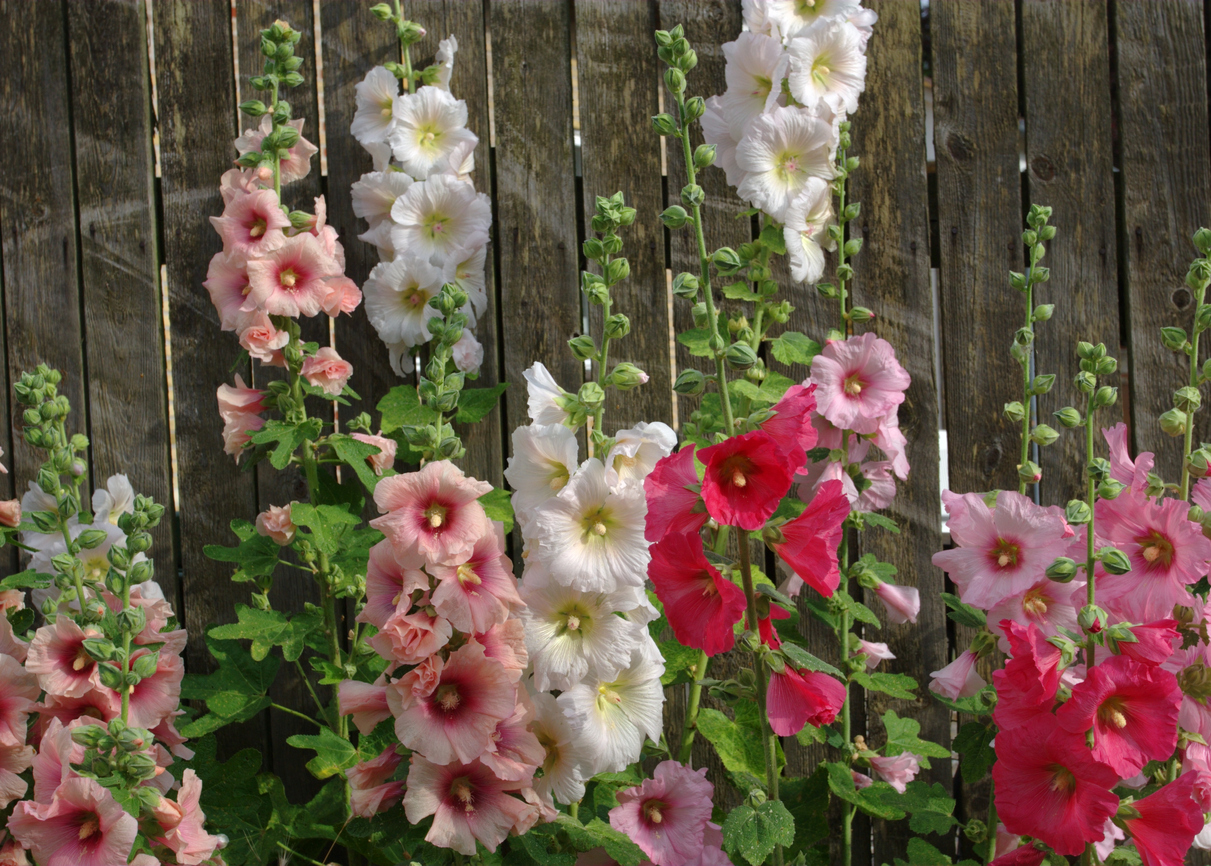
USDA hardiness zones: 5 to 9
Size: 5 to 8 feet tall
Red, orange, pink, white, and even black, hollyhocks are an heirloom garden classic for the summer flower lover. Most hollyhocks are biennials (living 2 years), but some can be perennial if cut back at the end of the growing season (late fall). In mild climates, hollyhock are prone to rust and might grow best as annuals. They like full to partial sun and because of their height, often require some support such as stakes or tying to a fence to keep the classic garden flowers upright.
22. Marigold (Tagetes patula)
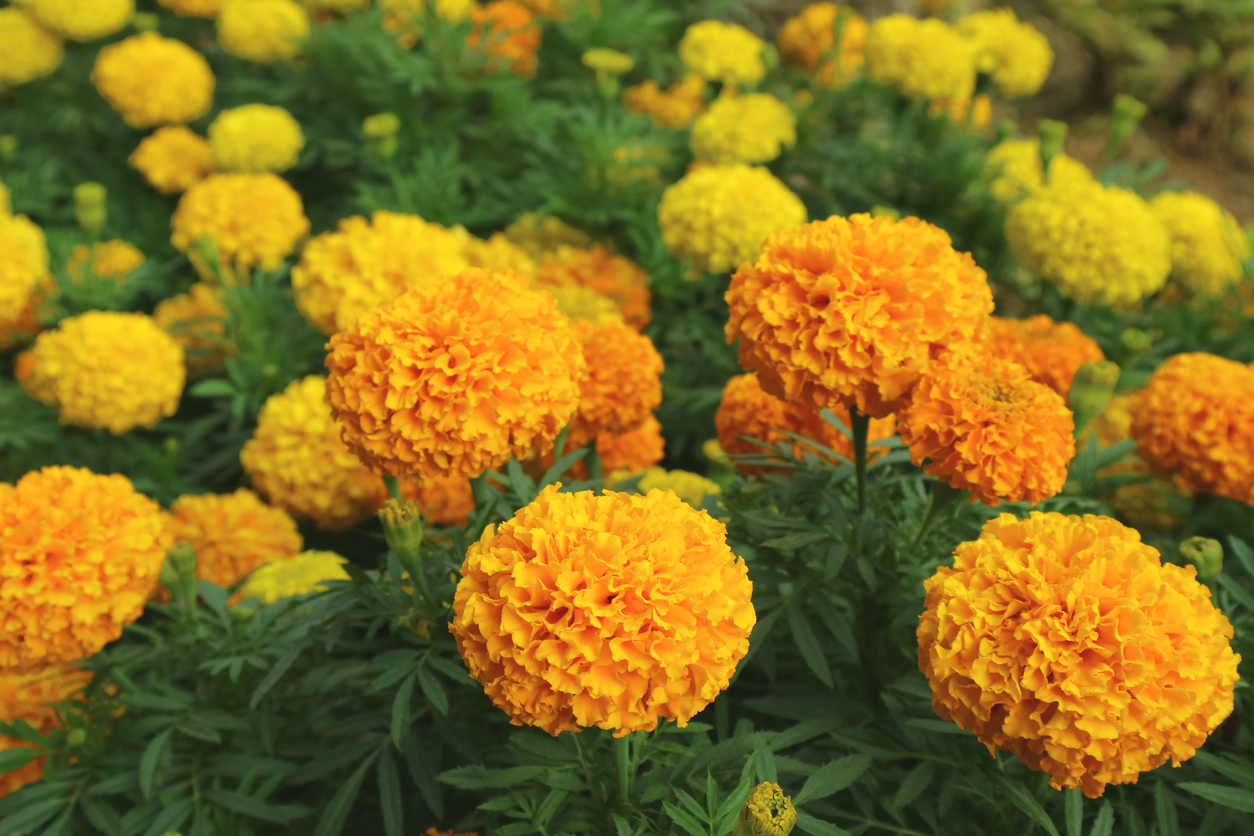
USDA hardiness zones: Annual in all zones
Size: 6 inches to 1 foot tall
The most common marigold sold in the United States is the French marigold (Tagetes patula), a brightly colored annual used in containers, borders, and beds from early summer to fall. The long-lasting blooms can be deadheaded regularly to encourage ongoing blooms well into the cool fall season, especially after heavy rains.
Marigold flower colors can range from bright orange and pale yellow to variegated red and gold. The flower prefers full sun and is frequently used as a companion plant to attract pollinators and deter pests from tender vegetables and herbs.
23. Coreopsis (Coreopsis spp.)
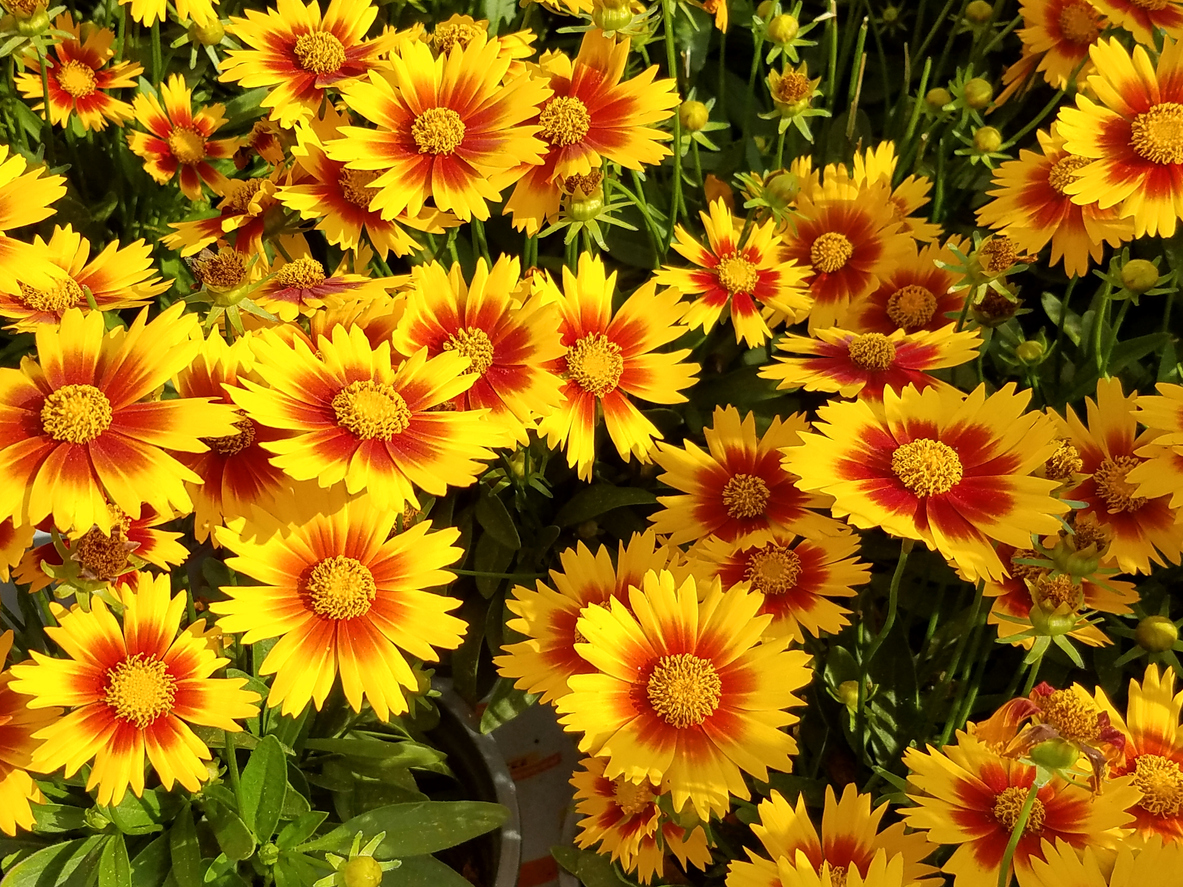
USDA hardiness zones: 5 to 9
Size: Up to 4 feet tall
Even beginning gardeners will find a friend in one of more than 80 varieties of coreopsis, an abundant bloomer. With both perennial and annual types, they produce flowers that are bright yellow, pink with dark centers, cream with pink centers, bright orange, and more. The plant fits in well in natural and woodland settings.
To keep coreopsis blooming well into the fall, grow them in full sun and regularly deadhead fading flowers. In general, coreopsis are drought-tolerant and attract pollinators, a winning combination for any garden bed.
24. Canna Lilies (Canna spp.)
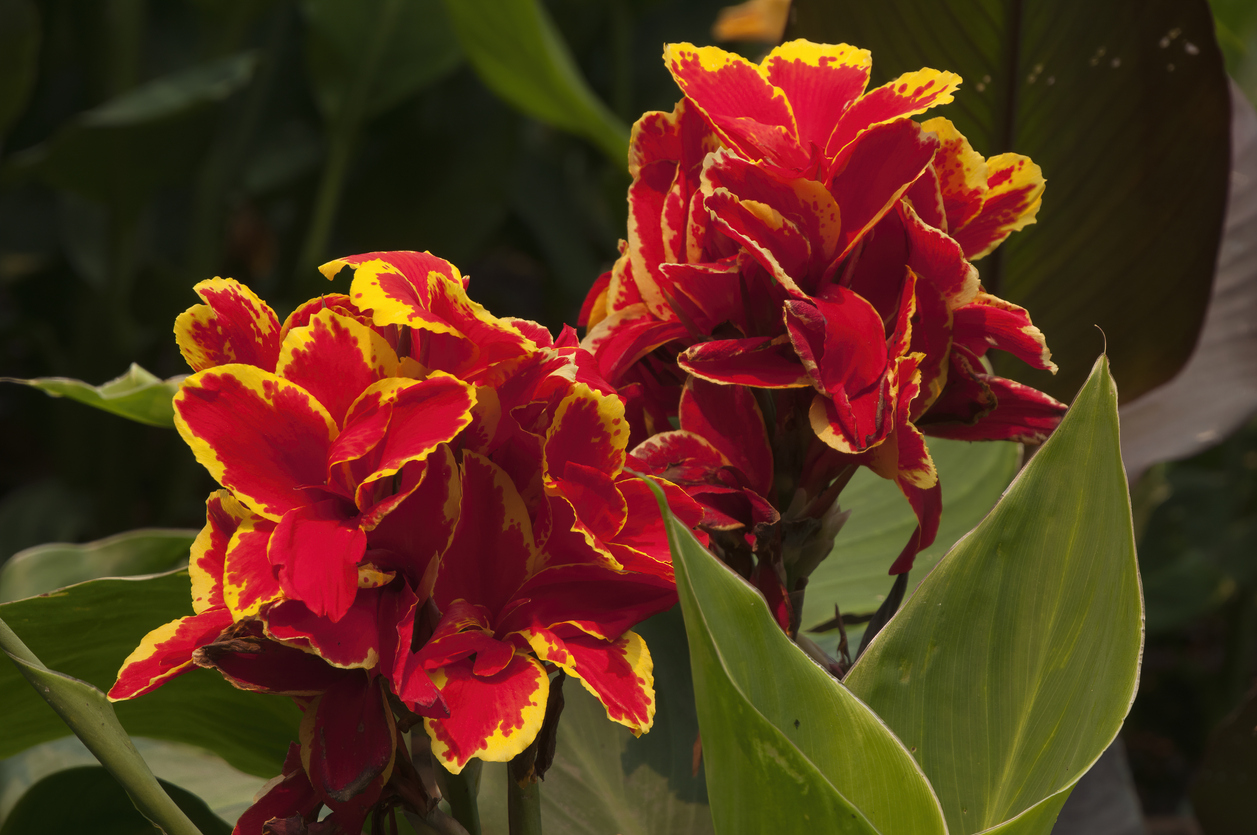
USDA hardiness zones: 7 to 11
Size: 1.5 to 5 feet tall
Tropical and subtropical plants grown as annuals in nearly all regions except for Zones 8 to 10, these beautiful, wide-leaved plants are beloved for their textured, colorful foliage with variations of color ranging from sunset-oranges to white and green stripes. Not a true lily, the canna has a rhizome that can be dug up and replanted each spring with other summer-flowering bulbs.
Some gardeners overwinter cannas as houseplants. Because of their showy leaves, they look great in garden beds and containers alike well before blooming. However, in late summer and early fall, they will produce spikes of flowers in red, orange, yellow, cream, pink, or bicolor. Canna lilies need plenty of water and sunlight to grow, but they can tolerate partial sun in hot summer climates.
25. Sally Holmes Rose (Rosa ‘Sally Holmes’)
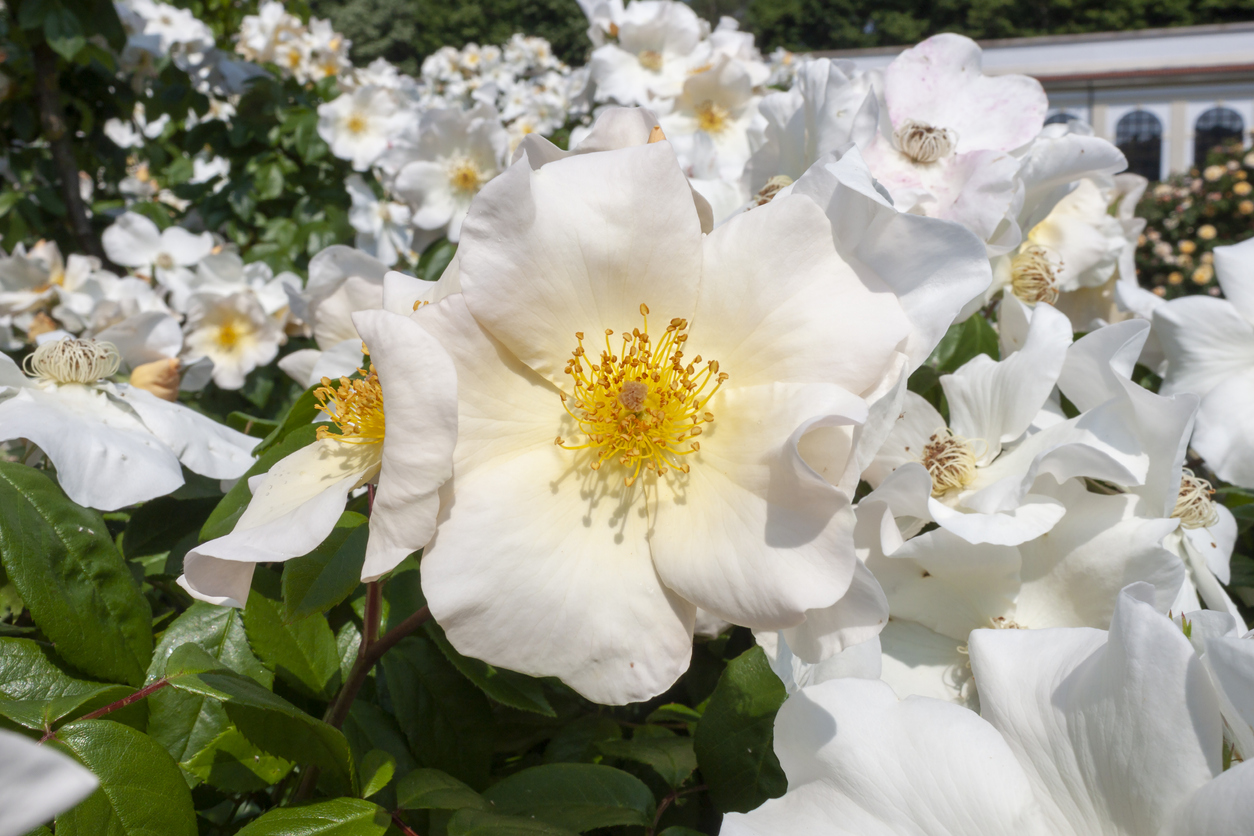
No doubt roses are the harbingers of summer, with most varieties beginning to bloom in late spring through midsummer—but there are a few varieties of roses that prefer to show off their blooms in late summer and early fall. The Sally Holmes climbing rose is a thornless climbing rose that produces large, fragrant flowers in a creamy white with yellow centers, almost like small fried eggs. Plant in rich soil in full sun and give it regular water, and it will provide you with endless blossoms until the leaves begin to turn. It grows to a height of 10 feet and is hardy down to Zone 6.
